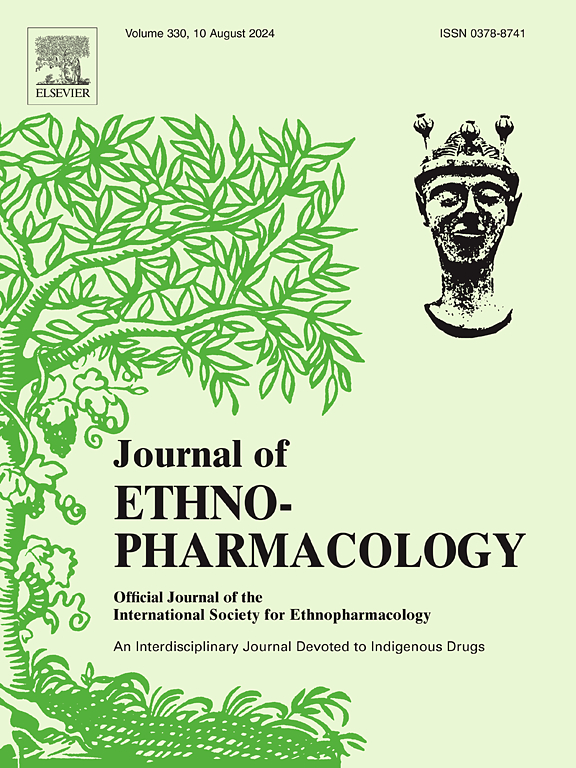Exploring the mechanism of feiyanning formula and its extract apigenin against EGFR-TKIs resistance in non-small cell lung cancer based on UPLC-HRMS and experimental validation
IF 5.4
2区 医学
Q1 CHEMISTRY, MEDICINAL
引用次数: 0
Abstract
Ethnopharmacological relevance
Drug resistance in lung cancer poses a significant challenge in clinical treatment. Feiyanning formula (FYN) is a traditional Chinese medicine formula developed through years of clinical practice. However, the specific mechanisms by which FYN and its extract inhibit drug resistance in lung cancer remain unclear.
Aim of the study
This study aims to elucidate the therapeutic potential and underlying molecular mechanisms of FYN and its extract in the treatment of lung cancer.
Methods
To explore how FYN interacts with potential targets in treating non-small cell lung cancer (NSCLC), a comprehensive strategy was employed, including network pharmacology, ultrahigh-performance liquid chromatography coupled with high-resolution mass spectrometry (UPLC-HRMS), cellular assays, animal models, and molecular docking. Protein-protein interaction (PPI) network construction and functional analysis were used to investigate how FYN and its extract, apigenin, may overcome resistance to epidermal growth factor receptor tyrosine kinase inhibitors (EGFR-TKIs). The molecular mechanisms were further validated using an NSCLC resistance animal model.
Results
The study confirmed that FYN and its extract inhibit the proliferation, migration, and invasion of H1975OR cells. Using network pharmacology and UPLC-HRMS, shared components between the FYN formula and drug-containing serum were identified, and a potential target network related to NSCLC resistance was constructed. Gene enrichment analysis indicated that FYN targets the IGF1R-PI3K-Akt signaling pathway in combating NSCLC resistance. Molecular docking revealed interactions between FYN's extract and key pathway-related genes. Cell phenotype assays showed that FYN not only suppresses proliferation, migration, and invasion of resistant NSCLC cells but also induces apoptosis and promotes cell cycle arrest. Additionally, animal experiments demonstrated that FYN significantly inhibits the growth of H1975OR xenografts in nude mice. Western blot analysis suggested that FYN may suppress the IGF1R-PI3K-Akt pathway in vivo.
Conclusions
This study explores the pharmacological effects and underlying mechanisms of FYN and its extract, apigenin, in the treatment of drug-resistant NSCLC. The findings support the therapeutic efficacy of FYN as a potential clinical treatment for lung cancer and provide robust scientific evidence for further investigation into the mechanisms of osimertinib resistance and the action of FYN.

肺炎宁方及其提取物芹菜素抗非小细胞肺癌EGFR-TKIs耐药机制的UPLC-HRMS及实验验证
民族药理学相关性:肺癌耐药对临床治疗提出了重大挑战。肺炎宁方(FYN)是经过多年临床实践开发的中药配方。然而,FYN及其提取物抑制肺癌耐药的具体机制尚不清楚。研究目的:本研究旨在阐明FYN及其提取物治疗肺癌的治疗潜力和潜在的分子机制。方法:采用网络药理学、超高效液相色谱-高分辨率质谱联用(UPLC-HRMS)、细胞实验、动物模型、分子对接等综合手段,探讨FYN与潜在靶点治疗非小细胞肺癌(NSCLC)的相互作用机制。通过蛋白-蛋白相互作用(PPI)网络构建和功能分析,研究了FYN及其提取物芹菜素如何克服对表皮生长因子受体酪氨酸激酶抑制剂(EGFR-TKIs)的抗性。通过NSCLC耐药动物模型进一步验证了分子机制。结果:本研究证实FYN及其提取物对H1975OR细胞的增殖、迁移和侵袭均有抑制作用。利用网络药理学和UPLC-HRMS技术,鉴定FYN方剂与含药血清的共享成分,构建与NSCLC耐药相关的潜在靶点网络。基因富集分析表明FYN靶向IGF1R-PI3K-Akt信号通路对抗NSCLC耐药。分子对接揭示了FYN提取物与关键通路相关基因之间的相互作用。细胞表型分析表明,FYN不仅能抑制耐药NSCLC细胞的增殖、迁移和侵袭,还能诱导细胞凋亡,促进细胞周期阻滞。此外,动物实验表明,FYN显著抑制H1975OR裸鼠异种移植物的生长。Western blot分析表明,FYN可能在体内抑制IGF1R-PI3K-Akt通路。结论:本研究探讨了黄芩苷及其提取物芹菜素治疗耐药NSCLC的药理作用及其机制。这些发现支持了FYN作为一种潜在的肺癌临床治疗方法的治疗效果,并为进一步研究FYN的奥西替尼耐药机制和作用提供了有力的科学证据。
本文章由计算机程序翻译,如有差异,请以英文原文为准。
求助全文
约1分钟内获得全文
求助全文
来源期刊

Journal of ethnopharmacology
医学-全科医学与补充医学
CiteScore
10.30
自引率
5.60%
发文量
967
审稿时长
77 days
期刊介绍:
The Journal of Ethnopharmacology is dedicated to the exchange of information and understandings about people''s use of plants, fungi, animals, microorganisms and minerals and their biological and pharmacological effects based on the principles established through international conventions. Early people confronted with illness and disease, discovered a wealth of useful therapeutic agents in the plant and animal kingdoms. The empirical knowledge of these medicinal substances and their toxic potential was passed on by oral tradition and sometimes recorded in herbals and other texts on materia medica. Many valuable drugs of today (e.g., atropine, ephedrine, tubocurarine, digoxin, reserpine) came into use through the study of indigenous remedies. Chemists continue to use plant-derived drugs (e.g., morphine, taxol, physostigmine, quinidine, emetine) as prototypes in their attempts to develop more effective and less toxic medicinals.
 求助内容:
求助内容: 应助结果提醒方式:
应助结果提醒方式:


